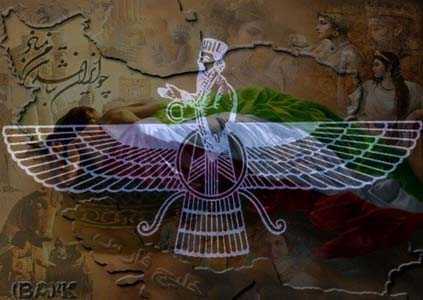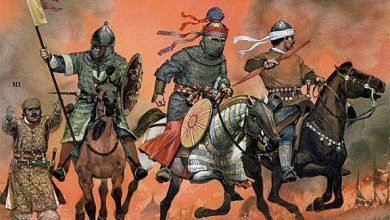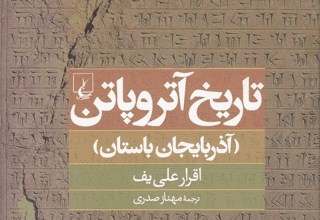Aryans migrated from Iran to other lands, not from outside to Iran !
Most of the historical sources, the people of Iran today consider the survivors of the Aryans who migrated from the distant northern lands to the south and the current land of Iran and destroyed the native peoples and civilizations of this land and replaced them. The history of these migrations has many differences in scope. A wide range of 3000 year to 5000 last year; And the initial origin of these migrations has been mentioned with greater differences, in a wide area from the west and north and center of Europe to East Asia, the Baltic Sea basin, the Scandinavian peninsula, the plains of North Central Asia and the Caucasus, Siberia and even the North Pole.. The wide range of these differences shows the laziness of the theories and the lack of reasons and arguments for it..
Most of the contemporary historical texts have concluded these origins and this great migration with only a few short, vague and imprecise sentences and they have not introduced these origins of migration precisely and have not discussed and analyzed them completely and sufficiently.. In these texts, it is often enough to draw a map with a few big arrows, which is drawn from the ends of Siberia and from the left and right of the Mazandaran Sea to the middle of Iran..
Since we know that human migrations and displacement of civilizations throughout history have always been due to achieving "better conditions for life", in ancient times these "better conditions" were especially more abundant water and more fertile soil.. If we can provide reasons for the assumption that in the ancient times, the climate characteristics and natural landscape in the Iranian plateau were more suitable than in the present day; And on the other hand, it should be clear that the weather characteristics in the northern lands of Iran were more unsuitable than today and even in ancient times; We can doubt the great migration of Aryans to today's Iran and even raise the possibility of migrations from Iran to other parts of the world..
Since the growth and increase of the population has always occurred in suitable and compatible ecosystems for humans, it seems unlikely that the ancient societies ignored the land with a suitable and moderate climate of Iran and lived in the always cold and frozen lands of Siberia. After that, they noticed Iran. And we also know that no settlements were found in those areas during the field research.
In this speech, we will deal with the hypothesis that Iranians or Aryans did not migrate "to Iran", but these Aryans are among the indigenous people living in Iran who migrated "in Iran" and "from Iran" and were dispersed..We know from archaeological evidence that the last ice age on earth, around 14000 It started last year and about 10000 It ended last year. Glacial periods cause the creation of large and vast glaciers in the poles and elevated mountains, and in the mid-latitude lands, including Iran, in the form of rainy and inter-rainy periods.. Rainy periods coincide with interglacial periods and interrainy periods coincide with glacial periods..
The sediments of the internal pits show that Iran witnessed heavy rains during the warm interglacial periods, which caused the establishment of wet weather conditions and the expansion of forests in Najd, Iran, and during the cold glacial periods, it welcomed cold and dry weather conditions..
In this way, about 10000 Last year, with the end of the last ice age, warm and humid weather conditions begin in Iran.. Archaeological evidence shows that with the beginning of the warm and humid period and the retreat of the glaciers towards the north, the amount of rainfall gradually increases.. so that about 6000 year to 5500 Last year to its maximum 4 until the 5 It was equal to today's average amount. After that, the water of the internal lakes rises and reaches its highest level, and all the holes, deserts, valleys and waterways are filled with water.. This is a period that is mentioned in the legends of different nations with different names, including the flood of Jamshid era and the flood of Noah. 4500 Last year, it gets more intense, but soon the rains will end and about 4000 Last year, a drought and a hot and dry period begins, which in 3800 It reaches its peak last year and as we will see later, this time coincides with the great displacement of civilizations in the plateau of Iran and the decline and extinction of many ancient settlements, cities and villages of Iran..
The warm and humid climate of the Middle Ages 10000 until the 4000 Years ago, it has arranged rich vegetation and dense and dense forests in the land of Iran and even in today's dry, waterless and grassy desert.. In that era, the expansion of forests and the retreat of hot deserts had formed a green and tan land in Great Iran, and the plains of today's northern Afghanistan were vast savannas. (Thin forests) and covered with moist grasslands. Abundant trees in the north of Afghanistan, especially the western part of it, where Badghis (In the Avesta "Weitigais") is read, It is reported in the Pahlavi text of his servant: “Vatgisan is a place full of trees”. This climatic condition of northern Afghanistan is also mentioned in the historical texts of the Middle Ages; In Moruj al-Zahb, Masoudi mentions beautiful Balkh with water, trees and many meadows; The Balkh preacher mentions one hundred thousand trees of Balkh in the virtues of Balkh. According to Shahriar Samani, Nizami Prozodi considers that place to be better than heaven because of its abundance and greenery. And Farieh Sayah considers Badghis pastures to be the best pastures in all of Asia. Today, large parts of Badghis and Balkh consist of dry deserts and flowing sands.. These flowing sands and burning deserts are seen more and more, especially around Kerman and Sistan; Whereas in the historical texts two thousand years ago, forests and meadows in these areas have been mentioned. At this time, the land of Iran had very rich pastures and abundant wildlife habitats..
In this area, there were ponds, reservoirs and natural wetlands with fresh water, which were the habitats of all kinds of aquatic animals and birds, as well as vast forests and dense reeds. According to the data of the above sections, in the distance 10000 until the 4000 Last year, hot and rainy weather prevailed throughout the plateau of Iran, and in addition, the level of the land and rivers, as well as the mouths of the rivers, were lower than today, and the level of lakes and reservoirs were higher than their current level, and as a result, all internal pits, lowlands Today's dry lakes, valleys, deserts and rivers have had plenty of fresh water and throughout Iran there has been a green climate with vast pastures and rich plant and animal products and suitable conditions for human life have been provided. Archaeological evidence of hot and humid weather conditions. in between 10000 until the 4000 The previous year is also confirmed by archaeological findings and signs. On the other hand, a large part of the ancient hills and ancient settlements of Iran date back to this period. 6000 They belong to warm and rainy year and all of them are located next to salt deserts, dry rivers and waterless and grassy areas, which is a sign of better weather conditions at the time of the formation and durability of those civilizations..
The establishment of these civilizations next to pits and dry deserts and salt fields was a sign of the presence of abundant and sweet water in them, and today's dry rivers near the hills provided enough and clear water for the inhabitants of the city or village..







Greetings and thanks, please. Also write the sources, I read on Google about an Iranian geneticist who proved that all Iranians are of the same race.. and are non-Aryan, please check
Have you even read the article that you say is a source? The source is mentioned in the article
No, there is no such Iranian geneticist who said that Iranians are not Aryans